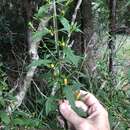Macranthera flammea
provided by EOL authors
Macranthera flamme, flame and hummingbird flower, is a biennial herb which can be found along the coastal plain of the United States from Georgia, Florida and eastward to Louisiana (NatureServe, 2014). Macranthera flammea, or (Alford and Anderson, 2002: 189). Macranthera flammea conservation status is vulnerable due to habitat fragmentation, forest management practices, and land-use conversion (NatureServe, 2014). Macranthera flammea can be found in bogs (NatureServe, 2014).
Macranthera flammea grows to be about 1 meter in height with 3-46 leaves per rosette (Anderson, 2002:192-193). Leaves are 3-33cm with upper leaves 4-7 cm long and up to 25 cm wide and lower leaves are 8.5-16cm long and 2-6cm wide (Alford and Anderson, 2002:192).
The common name hummingbird flower depends on hummingbirds for pollination (Alford and Anderson, 2002: 199). The flower has fused petals to form a tube, is bright orange, 2-2.5 cm in length, and has a nectar chamber (Alford and Anderson, 2002:192)
It was originally grouped under the family Scrophulariaceae until recently when it was shown placed in the family Orobanchaceae with other hemi-parasites (Alford and Anderson, 2002:189). Hemi-parasitic plants can penetrate the roots of a host plant even though it is capable of photosynthesis (Musselman, 1979: 479). Musselman and Mann (1979: 479) tested haustorial (root penetration) frequency of certain host plants in a greenhouse study. Macranthera flammea produced haustoria in 17 of 19 tree species (Musselman and Mann, 1979: 481). The host Fraxinus pennsylvanica had 225 haustoria as compared to the other host trees (Musselman and Mann, 1979: 481).
- license
- cc-by-3.0
- copyright
- Jessica Matthews; editor: Nisse Goldberg

